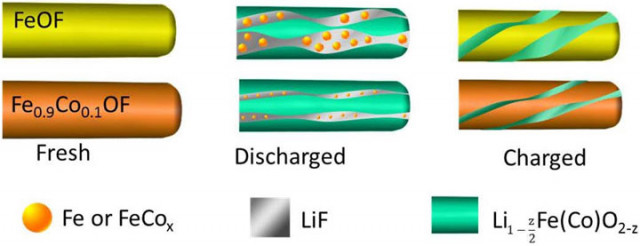
Adding oxygen and cobalt to the cathode prevents lithium from breaking chemical bonds
Researchers at the University of Maryland, in conjunction with Brookhaven National Laboratory have developed a new battery cathode material that they say could triple the energy density of lithium-ion batteries.
The new material is an engineered variety of iron trifluoride, a well-known material that has had problems with rechargeability and low power production.
In an article in the journal Nature Communications (via ChargedEVs), the researchers revealed how they took iron trifluoride’s inherent ability to absorb more lithium ions and added cobalt and oxygen to iron-trifluoride nano rods to make the material absorb and release lithium ions more quickly and readily.
In practical terms, the ability to store more lithium ions in the battery’s cathode, which increases energy density, is one of the keys to building better batteries for electric cars.
The higher the energy density, the smaller and lighter the battery pack can be for a given number of kilowatt-hours of electricity, which translates into critical miles for an electric car.
“Cathode materials are always the bottleneck for further improving the energy density of lithium-ion batteries,” said University of Maryland scientist Xiulin Fan.
Unlike conventional silicon cathodes, which absorb lithium ions without changing their structure, iron trifluoride converts into iron and lithium fluoride as it absorbs the lithium ions. The reaction isn’t easily reversible and is slower than the intercalation process of traditional silicon cathodes, according to the researchers.
The oxygen and cobalt coating on the nano-tubes better maintains the original structure of the iron trifluoride and makes the reaction easier to reverse to recharge the battery, the researchers say.
Researchers were able to look at the new material at a resolution of 0.1 nanometers using a transmission electron microscope, which allowed them to precisely engineer the materials.
Scientists around the world are still working on developing better battery materials for electric cars, cell-phones, laptop computers and other portable electronics to allow them to store more energy, and recharge faster and more reliably.
*Original article online at https://www.greencarreports.com/news/1117633_iron-triflouride-could-make-better-electric-car-batteries
